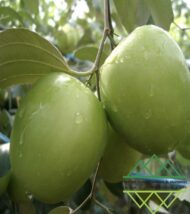






السدر التايلندي حلو الثمر Thai Sweet Sidr
AED 60 – AED 90Price range: AED 60 through AED 90
Details:
ثمار لذيذة… وشجرة تُثمر بغزارة وتُعطيك ما لذّ وطاب!
شجرة السدر التايلندي، المعروفة عالميًا باسم Thai Sweet Jujube، هي واحدة من أفضل أصناف Ziziphus mauritiana المُحسّنة، وتُعد خيارًا مثاليًا لعشاق الثمار الحلوة والمزارع التجارية الباحثة عن إنتاج وفير.
تتميز هذه الشجرة بإنتاجها الغزير من الثمار كبيرة الحجم، المستديرة وذات الطعم الحلو المنعش. وهي شجرة سريعة النمو، تتحمل حرارة الإمارات، وتثمر في وقت قصير بعد زراعتها.
⸻
المواصفات:
• يصل ارتفاعها إلى 3 – 5 أمتار، بعرض 2 – 4 أمتار.
• سريعة النمو وتبدأ بالإثمار خلال السنة الأولى.
• تتحمل الحرارة العالية، وتفضل المناخ الجاف الدافئ.
• ثمارها كبيرة الحجم، كروية، بلون أخضر يتحول إلى أصفر ذهبي عند النضج.
• لبّها أبيض مقرمش، خالٍ تقريبًا من الألياف، بطعم حلو يشبه التفاح.
• تحتوي الثمرة على بذرة واحدة فقط، مما يجعلها سهلة الأكل ومحبوبة لدى الأطفال.
⸻
الاستخدامات في التنسيق والزراعة:
• مثالية للحدائق المنزلية كمصدر دائم للثمار الطازجة.
• مرغوبة في الأسواق التجارية لسهولة تسويق ثمارها.
• تُزرع في المزارع المخصصة للإنتاج العضوي.
• تضاف في مشاريع التنويع الزراعي والمشاتل المتخصصة.
• تُستهلك ثمارها طازجة أو تُستخدم في تحضير العصائر والمربى.
⸻
العناية:
• الري:
• تُروى مرتين أسبوعيًا في السنة الأولى.
• بعد التأسيس، يُكتفى بريّها مرة أسبوعيًا حسب المناخ.
• التربة:
• تنمو جيدًا في التربة الرملية والطينية الخفيفة.
• تفضل التربة الغنية بالمواد العضوية وجيدة التصريف.
• التعرض:
• تحتاج إلى شمس كاملة (6 – 8 ساعات يوميًا).
• التقليم:
• يُفضل تقليمها سنويًا لتشجيع النمو وتنظيم التاج.
⸻
متوفرة الآن في مشاتلنا:
• أشجار ارتفاع 1 متر
• أشجار ارتفاع 2 متر
| Size |
1 meter ,2 meter |
|---|
Description
Plants
Croton, also called “garden croton,” are native to the tropical forests of southeast Asia and Oceania. In the wild, they grow as large shrubs, reaching up to 10 feet tall (in the home or garden, they stay a lot smaller).
Croton petra plants are susceptible to the bacterial diseases crown gall and xanthomonas leaf spot, and the fungal diseases anthracnose and stem gall and canker. Both crown gall and stem gall and canker present with swelling on the plant's stems, leaf veins and roots and require the pruning of all infected parts in order to be controlled. Xanthomonas leaf spot is identified through the dark brown and black lesions that appear on the leaves. A copper containing bactericide can be used preventatively, but once the plant is infected, it will need to be eliminated. If your plant has anthracnose, you'll notice water spots that turn tan and sometimes have black dots in the center.
Note: All parts of this plant are poisonous—especially the seeds—so it is not recommended for use in homes with curious pets or children. When damaged, croton produce a milky sap that can be irritating to the skin, too.

Visit the plant care library
Here you will find many useful tips for caring your plants.
How to Care for Croton
-
Place croton in a sunny location such as an eastern, southern, or western window. wd-furniture-dot-list
-
Keep the soil evenly moist, but let it dry out between waterings.
-
If humidity is low in your home, mist around the leaves with water once a week.
-
Gently wipe the leaves with a moist cloth twice a month to keep them clean.







Reviews
Clear filtersThere are no reviews yet.